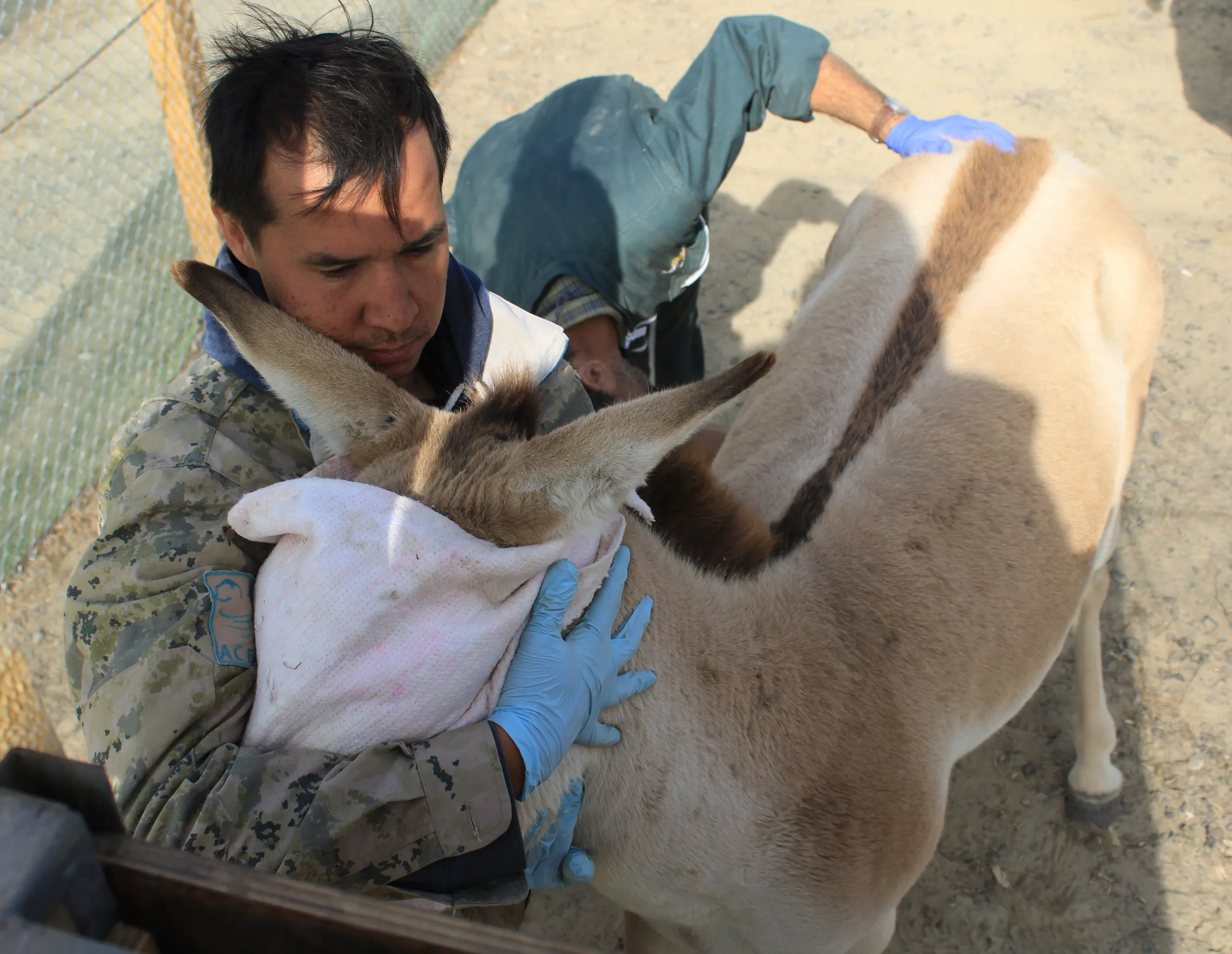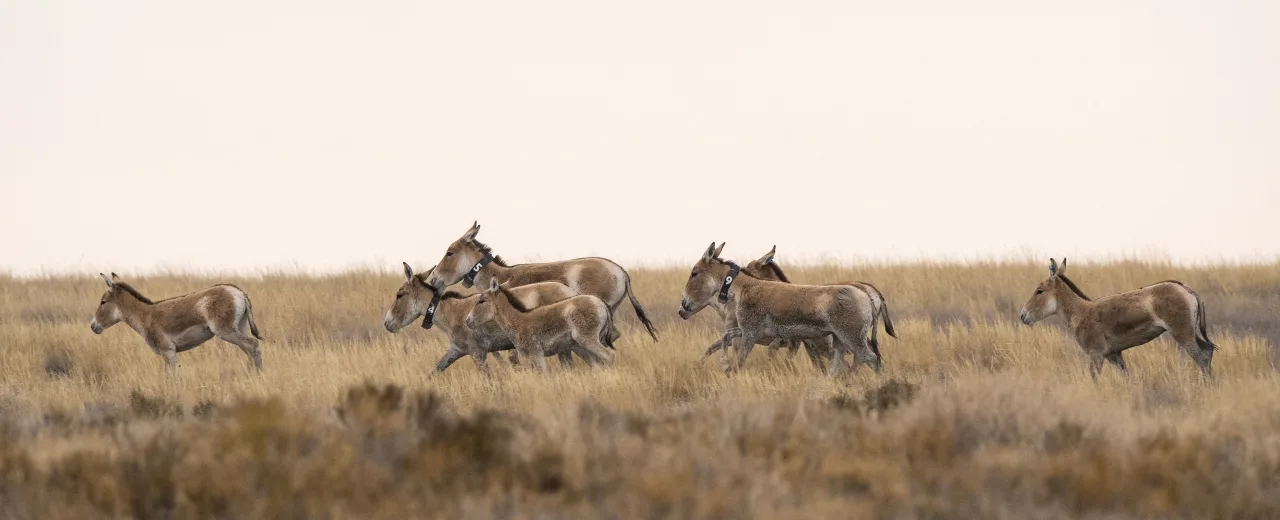 A collar that saves lives
A collar that saves lives
The donkey has landed: Kulans return to the steppe
Kulans - sounds cool! Kulans are wild donkeys, more precisely the Turkmen subspecies of the Asian wild donkey. They are slightly larger than the donkeys we know here and are not grey, but sand-coloured. Kulans can run incredibly fast: up to 75 km/h is no problem for these shy hoofed animals. In their homeland in the Central Asian steppes, it can sometimes be quite uncomfortable: hot +40 degrees in summer and icy -40 degrees in winter. Nevertheless, the coolies feel perfectly at home. In the course of the year, the length and density of their fur changes dramatically: while it is silky and smooth in the hot summer months, it turns into a fluffy winter coat in autumn. When the wind sweeps across the steppe in particularly cold weather, the donkeys stand close together in hollows or behind bushes and there stubbornly brave the elements. Food for the kulans is plentiful in the central steppe. Whether fresh and juicy or dried out and frozen - the steppe grass provides them with enough energy in all seasons. The grassland, which is so inhospitable for us bipeds, is therefore a paradise for kulans - boundless expanses and snacks as far as the eye can see.
Necessity
Protecting newly settled kulans from poaching
Activity
Local NGO puts collars with GPS transmitters on kulans so that rangers can monitor and protect the animals in the vast steppes
Countable effort
Number of Kulans that can be more effectively protected from poaching through GPS signals
Result
The chances of survival of the wild asses improve significantly because the animals can be protected more effectively from poaching
Systemic effect
Successful, long-term reintroduction of Kulans in Central Kazakhstan and stabilisation of the steppe ecosystem
Background
Originally, wild donkeys were widespread in the grasslands of Kazakhstan, a huge territorial state in the heart of the Eurasian continent. Poaching wiped out Kazakhstan’s culans around 1930. Today, the species is considered “critically endangered” (IUCN, 2016). But without wild asses, there is no intact steppe! As large herbivores, they are the gardeners of the grasslands, sowing, mowing, fertilising and harvesting: Kulans spread plant seeds over long distances, keep the vegetation low and thus reduce the risk of fires. Their hooves consolidate the soil and they are also a food source for predators and scavengers. As so-called “megaherbivores”, they also fulfil an important role for smaller herbivores. This is because they can dig water holes in dry riverbeds in summer and uncover grass under thick snow cover in winter.Poaching, the loss of grazing land in favour of growing livestock herds and the conversion of vast steppe areas into farmland drove the kulans out of the central Kazakh grasslands about a hundred years ago. Thanks to an ambitious reintroduction project led by the Kazakh NGO ACBK (Association for the Conservation of Biodiversity of Kazakhstan), the first animals are now returning to the steppe. In purely practical terms, it looks like this: Kulans are transported from a large population in the south of the country to the central steppe. There they spend several months under close observation in a large reintroduction enclosure. When it is clear that the animals are healthy and have adapted well to their new environment, they are released into the wild. In order to continue to protect them there and to establish a stable population in the long term, monitoring of the animals is imperative. GPS collars provide more security: they transmit the exact position of the settled kulans three times a day. The Kazakh rangers know exactly where the animals are and can therefore protect them better. This increases the chances of survival of the kulans as contribution to the preservation of the Kazakh steppe.
The good deed
Your donation today will support the purchase and operation of GPS collars for kulans in Central Kazakhstan. Adult animals are fitted with a collar that transmits their position for three years and then falls off on its own. The donkeys then receive a new collar. The transmitters are then collected and all the data stored on them is read out and analysed. The collar itself can then be reset and used again. Kulans easily walk 40 to 50 km in a single day. Without this monitoring technology, it is impossible for the gamekeepers to follow them in the vast steppe. Thanks to GPS collars, however, the rangers can accompany them and protect them from poaching. In the long term, they also identify the donkeys' routes and favourite places, which can then be specially protected. Improved ranger patrols give the wild donkeys a chance for a safe future on the steppe. It all starts with a GPS signal and your good deed!

About Kazakhstan
Astana
Capital
19,621.97
Number of inhabitants
11,243.7
Gross domestic product per capita per year
0,811
Human Development Index
Really athletic! Kulans can not only run incredibly fast, but are also impressive jumpers: they easily climb over fences of 1.80 m in height.
About the organization and further information
Association
Zoologische Gesellschaft Frankfurt von 1858 e.V.
Website
Further information and source
- Baumann, Matthias & Kamp, Johannes & Pötzschner, Flo & Bleyhl, Benjamin & Dara, Andrey & Hankerson, Brett & Prishchepov, Alexander & Schierhorn, Florian & Müller, Daniel & Hölzel, Norbert & Krämer, Roland & Urazaliyev, Ruslan & Kuemmerle, Tobias. (2020). Declining human pressure and opportunities for rewilding in the steppes of Eurasia. Diversity and Distributions.
- Kaczensky, Petra & Doldin, Ruslam & Enke, Dag & Linnell, John & Lukanovsky, Oleg & Salemgareyev, Albert & Sidorova, Tetyana & Sklyarenko, Sergey & Kisebaev, Talgat & Walzer, Chris & Ward, Stephanie & Zuther, Steffen. (2017). Feasibility study for kulan (Equus hemionus kulan) reintroduction into the central steppe of Kazakhstan.
- Kaczensky, Petra & Salemgareyev, Albert & Linnell, John & Zuther, Steffen & Walzer, Chris & Huber, Nikolaus & Petit, Thierry. (2021). Post-release Movement Behaviour and Survival of Kulan Reintroduced to the Steppes and Deserts of Central Kazakhstan. Frontiers in Conservation Science. 2.
- Kaczensky, Petra & Bayarbaatar, Buuveibaatar & Payne, John & Strindberg, Samantha & Walzer, Chris & Batsaikhan, Nyamsuren & Bolortsetseg, Sanjaa & Victurine, Ray & Olson, Kirk. (2021). A conservation strategy for khulan in Mongolia: background and key considerations.
- Kaczensky, P., Lkhagvasuren, B., Pereladova, O., Hemami, M. & Bouskila, A. 2016. Equus hemionus ssp. kulan. The IUCN Red List of Threatened Species 2016.




